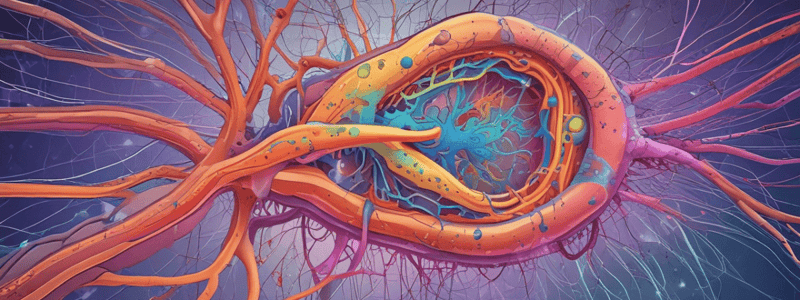Podcast
Questions and Answers
What is the primary role of the resting membrane potential in nerve cells?
What is the primary role of the resting membrane potential in nerve cells?
- To facilitate the transmission of signals between neurons
- To generate action potentials
- To regulate the flow of electrolytes across the cell membrane (correct)
- To maintain the cell's internal environment
What is the approximate resting membrane potential of cardiac and skeletal muscle cells?
What is the approximate resting membrane potential of cardiac and skeletal muscle cells?
- -50mV to -60mV
- -70mV to -75mV
- -85mV to -90mV (correct)
- -95mV to -100mV
Which of the following ions contributes to the negative resting membrane potential inside the nerve cell?
Which of the following ions contributes to the negative resting membrane potential inside the nerve cell?
- Na+
- Protein ions (correct)
- K+
- Cl-
What is the primary function of K+ leaky channels in the genesis of the resting membrane potential?
What is the primary function of K+ leaky channels in the genesis of the resting membrane potential?
Which of the following equations is used to describe the resting membrane potential in terms of the concentrations of ions inside and outside the cell?
Which of the following equations is used to describe the resting membrane potential in terms of the concentrations of ions inside and outside the cell?
What is the net effect of the Na+/K+ ATPase pump on the resting membrane potential?
What is the net effect of the Na+/K+ ATPase pump on the resting membrane potential?
What determines the development of the resting membrane potential?
What determines the development of the resting membrane potential?
What is the direction of the electrical gradient for Na+ ions across the cell membrane?
What is the direction of the electrical gradient for Na+ ions across the cell membrane?
What is the equilibrium potential at which Cl- influx equals Cl- efflux?
What is the equilibrium potential at which Cl- influx equals Cl- efflux?
What is the assumption of the Nernst equation regarding the membrane?
What is the assumption of the Nernst equation regarding the membrane?
What is the direction of the concentration gradient for K+ ions across the cell membrane?
What is the direction of the concentration gradient for K+ ions across the cell membrane?
Flashcards are hidden until you start studying
Study Notes
Resting Membrane Potential (RMP) and Nerve Physiology
- The resting membrane potential (RMP) is the electrical potential difference across the cell membrane in excitable tissues, such as nerve cells, cardiac cells, and skeletal muscle cells.
- The RMP of nerve cells is around -70mV, while that of cardiac and skeletal muscle cells is between -85mV to -90mV.
Genesis of the Resting Membrane Potential
- The RMP is due to the uneven distribution of electrolytes (Na+, K+, Cl-) inside and outside the cell membrane.
- An excess of nondiffusible protein ions and other anions inside the cell makes the inside of the nerve membrane more negative than the outside.
Role of Protein Channels and Carriers
- Two transport proteins are primarily responsible for the genesis of the RMP:
- K+ leaky channels
- Na+/K+ ATPase pump (an electrogenic pump that extrudes 3Na+ for every 2K+ ions, contributing a few mV to the RMP)
Development of the Resting Membrane Potential
- The RMP is developed largely due to diffusion forces, including concentration and electrical gradients for most ions across the cell membrane.
- The equilibrium potential, where the influx and efflux of Cl- are equal, is around -70mV.
Nernst Equation
- The Nernst equation is used to calculate the equilibrium potential (Em) of an ion:
- Em = RT/F * ln([X]0 / [X]i)
- Where R is the universal gas constant, T is the absolute temperature, F is the Faraday constant, Z is the valency of the ion, and [X]0 and [X]i are the concentrations of the ion outside and inside the cell, respectively.
Examples of Nernst Equation Calculations
- ECl- = -61 log (125/9) = -70mV
- ENa+ = +61 log (140/14) = +61 mV
- EK+ = +61 log (4/140) = -94.1 mV
Studying That Suits You
Use AI to generate personalized quizzes and flashcards to suit your learning preferences.





